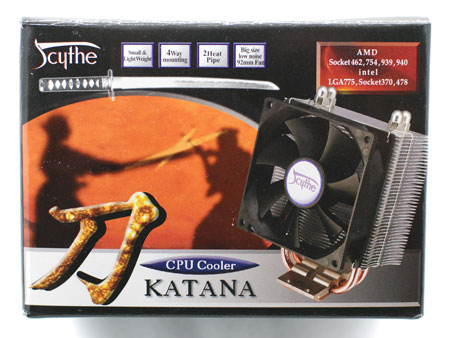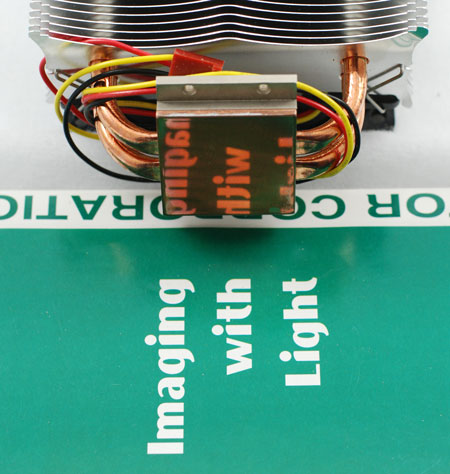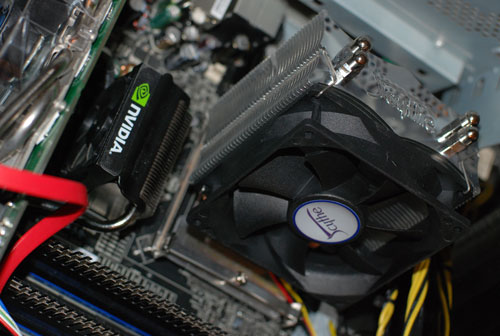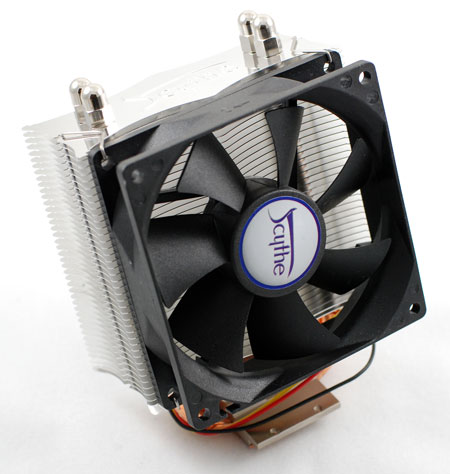Value Cooling: Two Towers for under $30
by Wesley Fink on January 23, 2007 3:50 AM EST- Posted in
- Cases/Cooling/PSUs
Scythe Katana
Scythe produces a wide range of air cooling solutions for the computer enthusiast. There are currently about a dozen air cooling solutions detailed on the company website. These range from entry level cooling solutions all the way to powerful cooling tower designs.
Scythe Co., Ltd is a Japanese company located in Tokyo. Beginning in 2002 Scythe started manufacturing and distributing products for the PC enthusiast, including CPU cooling solutions. Scythe's first product, the Scythe Samurai, developed quite a reputation among computer enthusiasts. Their current catalog includes the well-known full cooling tower solution, the Scythe Infinity.

Scythe likes using full color graphics and Japanese fight themes in their packaging. The Katana is no exception.

While the Thermalright MST-9775 is designed to support just the Socket 775, the Katana includes an incredible array of hardware to adapt it to AMD Socket A (462), 754/939/940, Intel 370, Intel 478, and Intel 775. It should also be mentioned that Katana is one of the few current coolers that actually meets AMD's recommendation of 300g maximum weight for Socket A coolers.

The mounting surface of Katana is highly polished. Many do not believe this matters much on processors with integral heatspreaders like Core 2 Duo, P4, Socket 478 and AM2. However, a smooth mating surface does matter a great deal on small surface area processors like Athlon XP and other Socket A designs.
With Katana supporting so many different sockets, it should be no surprise that some installations are easier than others. Installation on Socket A is a breeze, but Socket 775 installation is a nightmare. The motherboard has to be removed from the case to install the back plate and adapters which basically make 775 into a Socket 478 cage. Then you have to install flat "clips" with a set screw to create the pressure to hold the cooler in place - all while holding the cooler.

The point is the installation is possible, but we could find no way to do it in a case. Install the cooler before remounting the motherboard. The finished Core 2 Duo install took a while, but once it is done properly, the cooler works just fine on a Core 2 Duo processor.

Scythe also suggests that the Katana be mounted so the fan, which blows through the fins/heatpipes, is aimed toward a rear exhaust. This works well in cases with a top-mounted power supply. In designs with the power supply at the bottom of the case a top exhaust should also work fine.
The Scythe Katana uses a large 92mm fan that runs at just one speed - 2000rpm. There are no provisions for variable fan speed, but you can add a fan controller like the Zalman if you want. There is also an upgraded Katana model - the Katana CU - which adds all copper construction and a fan controller to the base Katana for about $15 more (total $40).
Scythe produces a wide range of air cooling solutions for the computer enthusiast. There are currently about a dozen air cooling solutions detailed on the company website. These range from entry level cooling solutions all the way to powerful cooling tower designs.
Scythe Co., Ltd is a Japanese company located in Tokyo. Beginning in 2002 Scythe started manufacturing and distributing products for the PC enthusiast, including CPU cooling solutions. Scythe's first product, the Scythe Samurai, developed quite a reputation among computer enthusiasts. Their current catalog includes the well-known full cooling tower solution, the Scythe Infinity.

Scythe likes using full color graphics and Japanese fight themes in their packaging. The Katana is no exception.

While the Thermalright MST-9775 is designed to support just the Socket 775, the Katana includes an incredible array of hardware to adapt it to AMD Socket A (462), 754/939/940, Intel 370, Intel 478, and Intel 775. It should also be mentioned that Katana is one of the few current coolers that actually meets AMD's recommendation of 300g maximum weight for Socket A coolers.

The mounting surface of Katana is highly polished. Many do not believe this matters much on processors with integral heatspreaders like Core 2 Duo, P4, Socket 478 and AM2. However, a smooth mating surface does matter a great deal on small surface area processors like Athlon XP and other Socket A designs.
With Katana supporting so many different sockets, it should be no surprise that some installations are easier than others. Installation on Socket A is a breeze, but Socket 775 installation is a nightmare. The motherboard has to be removed from the case to install the back plate and adapters which basically make 775 into a Socket 478 cage. Then you have to install flat "clips" with a set screw to create the pressure to hold the cooler in place - all while holding the cooler.

The point is the installation is possible, but we could find no way to do it in a case. Install the cooler before remounting the motherboard. The finished Core 2 Duo install took a while, but once it is done properly, the cooler works just fine on a Core 2 Duo processor.

Scythe also suggests that the Katana be mounted so the fan, which blows through the fins/heatpipes, is aimed toward a rear exhaust. This works well in cases with a top-mounted power supply. In designs with the power supply at the bottom of the case a top exhaust should also work fine.
The Scythe Katana uses a large 92mm fan that runs at just one speed - 2000rpm. There are no provisions for variable fan speed, but you can add a fan controller like the Zalman if you want. There is also an upgraded Katana model - the Katana CU - which adds all copper construction and a fan controller to the base Katana for about $15 more (total $40).










28 Comments
View All Comments
orangesky - Tuesday, January 23, 2007 - link
Since the Thermalright fan blows down towards the motherboard (as does Intel's stock HSF), but the Katana blows across (and out of the case), it seems like there would be a noticable air flow difference on the components around the CPU (e.g., VRM, memory, and NB).Was there any difference noted in the temperature of the "motherboard" (which probably is the NB)? I'm wondering if this is a concern or not, especially for OC'ing?
Spacecomber - Tuesday, January 23, 2007 - link
For coolers, like the Katana, which lack 4-wire connectors that 775 motherboards can automatically adjust fan speeds via, perhaps it would be helpful to take advantage of speedfan for comparing cooling across a range of fan speeds. (This is assuming that the relatively new 680i motherboard that you are using is supported by SpeedFan.)Doh! - Tuesday, January 23, 2007 - link
A new version of Katana has a 4-wire connector. I just bought one last week. The box has 775 written on it and does not come with a back plate.Wesley Fink - Tuesday, January 23, 2007 - link
Scythe has introduced another version of the Katana called the Katana 775. This was to address the installation and fan speed issues we discussed. The Katana 775 only fits Socket 775 and it comes with a 4-pin fan header. The original Katana, with universal installation as we reviewed here, continues as a current product.If you are only concerned with Socket 775 the Scythe Katana 775 looks lik a much better choice with easier installation and fan speed control at the same price or less than the original Katana.
KorruptioN - Tuesday, January 23, 2007 - link
For under $30, I think the Arctic Cooling Freezer 7 Pro should've been included. Quiet, not so heavy, with very good performance for the money.Wesley Fink - Tuesday, January 23, 2007 - link
We are not finished with coolers under $30, and we will try to include the Arctic Cooling Freezer 7 Pro in our upcoming value cooler roundup. The Freezer 7 Pro also uses a 92mm fan, but it weighs a bit more than this pair at 520g (vs. 300g and 420g).mostlyprudent - Tuesday, January 23, 2007 - link
I notice in the noise charts that the Retail HSF is only listed once. Is this at its idle speed? I may have missed it in the review, but what is the RPM range of the retail HSF?BTW, nice article.
Wesley Fink - Tuesday, January 23, 2007 - link
The Intel Retail HSF was below the system noise floor at both high and low speeds. We will try to make this clearer in future reviews.